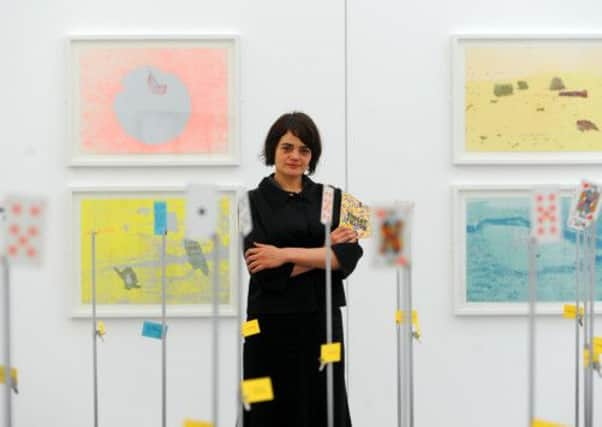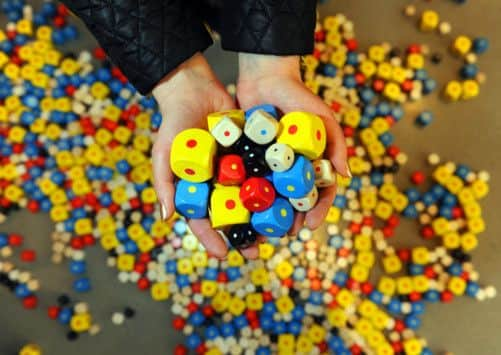Throwing a one – but racking up the total score


You’ve got to wonder when the enthusiasm is going to start wearing off.
Not at the very least until the end of the latest exhibition she’s curated, is the answer.
Advertisement
Hide AdAdvertisement
Hide AdLisa Le Feuvre is the highly respected academic and curator who Leeds is lucky to have. She moved from her impressive job teaching at Goldsmiths, where she had been marked for great things, to take the only job that could tempt her away from London.


She came to Leeds to replace Penelope Curtis as the woman in charge of the Henry Moore Institute.
Le Feuvre is clearly an intellectual force and has to have some chutzpah about her to be steering an organization as big and as internationally significant as HMI, yet she retains the common touch and wears her learning and her position lightly.
It’s as easy to imagine her laughing over a coffee as giving a lecture on some obscure aspect of sculpture.
Advertisement
Hide AdAdvertisement
Hide AdThe latest exhibition Le Feuvre has curated at the organisation of which she is in charge is the perfect demonstration of this duality.
She laughs as she enters a room of the exhibition and picks up one of the hundreds of coloured dice scattered on the floor picking it up and throwing it, delighting that each of the cube’s sides has a single dot. You can only ever throw a one.
She is equally delighted when explaining Robert Fillipou’s notions of how we appropriate and interact with great works of art, showing off his representation of the Mona Lisa.
Before we come on to the latest exhibition, first, Le Feuvre.
Advertisement
Hide AdAdvertisement
Hide AdYoung and female in a world where the people in charge are generally the opposite, Le Feuvre’s job is one of the most significant in British Sculpture and has an international reputation. She has been in charge of the Henry Moore Institute since November 2010.
“I have to admit that now, these days, it does feel like it’s ‘my’ institute,” she says, beaming. “I think it took about a year and a half for that to happen, but I think that happens with every single job – that there’s a moment where you suddenly realise that, actually, it doesn’t matter if you don’t know exactly what happened in 1986 in the organisation or whatever – you know enough to be able to represent the organisation.
“I do remember there was a moment where I felt really confident in myself, in the institute and that we were doing what I wanted us to do, I no longer felt new.”
Le Feuvre, a new breed of art world academics for whom the art of communication is of paramount importance, perhaps even equal to the art itself, admits that there was a management curve on which she found herself. The first six months was a case of being excited about all the opportunity, the second six months was spent wondering if she’d made the correct decision in coming to Leeds.
Advertisement
Hide AdAdvertisement
Hide Ad“It is really important to question yourself – to ask ‘am I right for this?’ Of course there are obstacles, but after that second six months I decided this is the right place, there’s nowhere else I want to be right now.”
The Henry Moore Institute, funded by the foundation of the man who gives the organisation its name, is in a rare and privileged position in the current climate. Driven by neither a need to fulfil public funding obligations, nor commercial concerns, the HMI, a gallery and research centre at the heart of Leeds, it can concentrate entirely on what is important.
“What matters is driving forward sculpture. We can just start with sculpture, we don’t need to do anything else.
“I used to say this as rhetoric, now I know it’s true – if you start with art, if you start with sculpture people are going to come. If you try to give people what you think they want, you’ll never get it right.”
Advertisement
Hide AdAdvertisement
Hide AdLe Feuvre, who is absolutely not the sort to succumb to hyperbole, uses a phrase that makes it clear why she is in Leeds and why we are going to have her in the city for a little while yet.
“We have one job and that is to make the future of the history of art.
“That’s really simple, but it’s a massive responsibility and we have to get it right.
“You can only make the future of the history of art if you are prepared to test things out and prepared to get people in to engage with it.”
Advertisement
Hide AdAdvertisement
Hide AdThe latest exhibition Le Feuvre has curated to help create this future of the history of art is Robert Filliou, which opened to the public today.
The first solo exhibition of the French artist’s work in the UK, Filliou has a connection to Leeds.
“He famously said ‘Art is what makes life more interesting than art’,” says Le Feuvre.
“When we are planning an exhibition we always ask ‘why here, why now?’ We discovered that Filliou actually came to Leeds in 1969, brought by a teacher at the Leeds College of Art.
Advertisement
Hide AdAdvertisement
Hide Ad“In the 1960s, in Leeds there was this wave of radical pedagogy and a teacher at the college organised for Yoko Ono to come to Leeds to do some performance art, and the other person invited was Robert Filliou.
“While here he invented a card came, called Leeds – which involves a lot of drinking, the players being blindfolded and the audience shouting instructions to the players who are using double-sided cards.
“The players have to trust the audience and allow their moves to be orchestrated by people who are watching over them. If we were in France, this exhibition would be very significant, but because he is not as well known in Britain I expect it to be very popular, but more of a slow burn. His art was essentially about research into the way people live. It seems perfect for us.”
Le Feuvre believes that ‘elitism is bad, but being elite is good’. If her aim, two-and-a-bit years ago when she arrived in Leeds, was to make the Henry Moore Institute less elite, while keeping it at the top of the art world, she can consider the job done. But she clearly isn’t finished yet.
A sponge for inspiration
Advertisement
Hide AdAdvertisement
Hide AdRobert Filliou was a member of Fluxus, the 1960s performance group and uses cardboard, wood and often found objects to create his work.
He is perhaps most famous for his declaration, on January 17, 1963, that Art had been born a million years ago, when someone dropped a dry sponge into a bucket of water.
Filliou’s invention of Art’s Birthday was an absurd and humorous invention, typical of the ‘Fluxus’ movement.
It has since become an idea that artists around the world picked up on and have since celebrated every decade.
Robert Filliou: the Institute of Endless Possibilities, Henry Moore Institute, Leeds, to June 23.